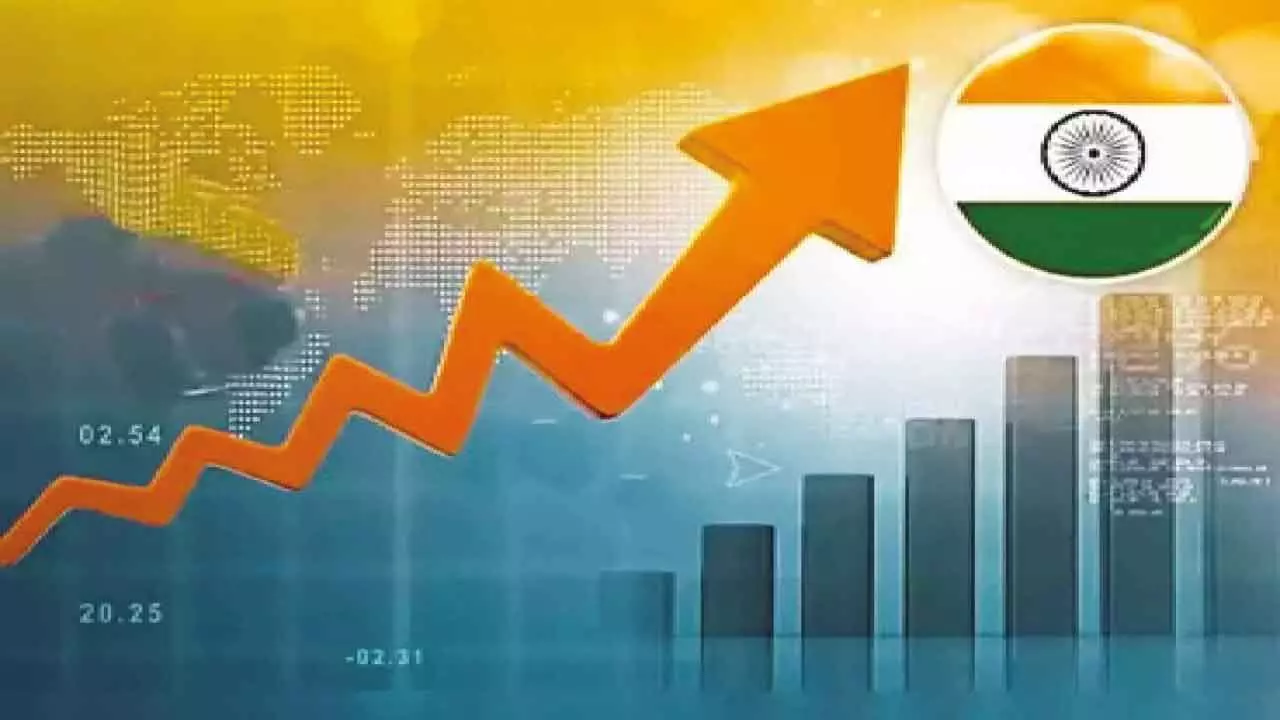India Poised For Economic Powerhouse Status In 2025
The projected economic growth into 2025, driven by government spending, consumer resilience, and potential policy support, paints a promising picture
India Poised For Economic Powerhouse Status In 2025

India’s ability to capitalise on shifting global trade dynamics, particularly amidst US-China tensions, presents a unique opportunity to strengthen its manufacturing sector and global economic role. Furthermore, the country's focus on economic diversification, job creation, and sustainable energy development will be vital for long-term prosperity
India stands to gain from the shifting dynamics in global trade, particularly due to US-China trade tensions. As countries reconsider their supply chain strategies, India can position itself as an attractive manufacturing hub, especially in mid-tech sectors like textiles and electronics. By negotiating and expanding Free Trade Agreements (FTAs), particularly with major partners such as the US, India can reduce tariffs on its exports, which will boost sectors like textiles that have historically struggled with high tariffs. While India did not significantly benefit from previous global supply chain shifts, it has a unique opportunity in 2025 to capitalise on these changes and strengthen its role in the global economy.
By focusing on diversifying its economy, India can create more sustainable job opportunities, reduce regional disparities, and foster greater economic inclusivity. These efforts will not only support the country’s transition towards a more resilient and competitive economy but also enable it to fully leverage its demographic advantage, turning challenges into opportunities for widespread prosperity.
Policy decisions henceforth will influence greatly whether India rises to the challenge of becoming a global powerhouse that leaves no one behind or whether it falters under the weight of unresolved inequalities and environmental threats.
Although several global economic challenges loom in the near term, some challenges can be turned into opportunities with appropriate policy interventions. Proactive measures to address the adverse consequences of policy uncertainty, trade disruptions, and geopolitical tensions will be crucial in building a more resilient global economy that can withstand future shocks.
The growth momentum is expected to improve entering 2025, as government spending picks up again and consumer sentiment stays resilient. This should enable better earnings growth, amid an improving economic backdrop that may also find support from favorable monetary and fiscal policies.
India’s economic growth slowed in 2024, with gross domestic product (GDP) year-on-year growth of just 5.4 per cent in the fiscal second quarter (July-September), the lowest in seven quarters. As a result, growth for the full fiscal year ending March 2025 will likely be 6.6 per cent, moderating from 8.2 per cent from a year earlier, based on Reserve Bank of India (RBI) forecasts.
Government cash balance—a major indicator for government spending—dropped to a deficit of Rs 458 billion ($5.4 billion) in the first week of December. This figure has been on a downtrend since September, suggesting that the government is gradually ramping up its spending on priority initiatives, particularly infrastructure and rural development. Importantly, a pickup in government spending and activities should synergize capital expenditure (capex) growth in the private sector. For instance, we may see faster approvals for construction and engineering projects, bolstering company confidence to invest and hire more actively. Consumption growth should find further support if inflation cools in 2025.
The recovery of domestic private consumption and government spending should drive the improvement of India’s economic momentum. These are also key factors that should catalyze a reacceleration in corporate earnings growth.
A third factor that we are monitoring is the tailwind arising from stable inflation and a favorable fiscal policy position. These trends may lead to interest rate cuts in 2025, especially given the moderation of CPI inflation towards the 4 per cent target rate. As for fiscal policies—we note that the government’s focus on lowering fiscal deficit may limit policy flexibility, but additional measures to spur growth recovery in 2025 cannot be ruled out.
India can comfortably maintain its position as the world’s fastest-growing major economy, with GDP growth of around 6.5 per cent until at least 2029. Income growth and the rise of the middle class will likely continue in tandem. India’s wealthy and middle-class populations is likely to expand by 400 million people. In particular, the number of people in India’s wealthiest class could grow three-fold.
India is on the right track in its renewable energy journey, but true readiness will be tested by the nation’s ability to integrate variable sources into its grid. The future depends on visionary planning, innovation, and infrastructure advancements to create a resilient and sustainable energy system.
While progress is underway, there are opportunities to further refine the approach. The existing regulatory framework inadequately captures the full value of BESS, creating a significant financial viability gap compounded by high financing costs and limited monetization opportunities.
To overcome these hurdles and accelerate the deployment of energy storage systems, India must embrace forward-thinking financing solutions and enact supportive policy reforms. By addressing these issues, India can not only bolster grid resilience and achieve its renewable energy targets but also position itself as a global leader in the energy transition, driving innovation and setting benchmarks for others to follow.

